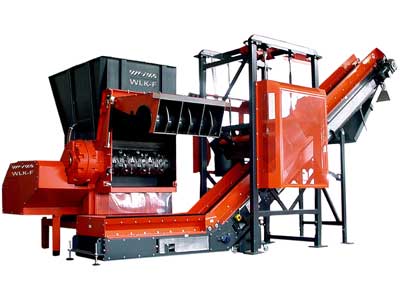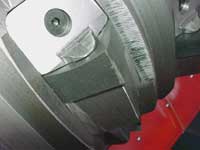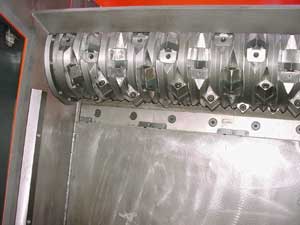|
Size-reduction of thermoplastics reinforced by long and continuous filaments
Hans-Peter Fischer, WEIMA Maschinenbau GmbH
Material utilisation of thermoplastics reinforced by long and continuous filaments to produce high-value, long-filament reinforced extrusion components requires a gentle size-reduction of the materials to be utilised into lumps of grinding stock in order to achieve a large as possible filament length. The properties of the components to be produced out of this grinding stock are determined by the filament length to a large extent. This is why the size-reduction unit used is of considerable importance. In a project supported by the "Deutsche Bundesstiftung Umwelt" ["German Federal Foundation Environment] M/s. WEIMA Maschinenbau GmbH, Ilsfeld, along with renowned partner companies developed the series WLK-F (Photo 1).

Slight construction through filaments
In recent years, thermoplastics reinforced by short filaments have won recognition particularly in automobile slight construction. Thermoplastics reinforced by long filaments in the form of glass-mat reinforced thermoplastics (GMT) as well have been used more and more in industrial scale manufacture. Thermoplastics reinforced by continuous filaments are a relatively young material group the use of which is pushed forwards particularly by all renowned national and international automobile manufacturers for components or whole car bodies made of fibrous plastics. So far important applications have been underside panelling, seat shells, sound capsules and bumpers. Current developments plan to use long-filament granulates and so-called organo sheets (thermoplastics reinforced by fabric) from the group of thermoplastics reinforced by continuous filaments. For the years to come an increasing volume of old parts and production waste in the form of punched parts, edge cuttings, etc. from thermoplastics reinforced by long and continuous filaments has to be reckoned with.
Prerequisite for a high-value utilisation of these components is a size reduction which produces a grinding stock in lumps in order to guarantee a certain filament length. Moreover, the matrix must not be burdened too much in order to avoid crack introduction and/or crack spread as well as thermal damage. Thermoplastics reinforced by long and continuous filaments possess a tough elastic matrix and brittle filaments. This is why they are not characterised by any definite rupture behaviour.
Optimal filament length permits high-value utilisation
In the course of the research project all existing size-reducing units such as cutting mills, two- and four-shaft shredders as well as one-shaft size reduction machines were tested. An important result was that the long filaments were crushed during the size-reduction trials and only a small portion of the produced grinding stock possessed a defined medium filament length. This result was independent of the size-reducing technology used. Another problem was a too high fine portion which, among other reasons, was caused by the friction between rotor and screen.
In the course of the trials performed the production of roughly reduced thermoplastics reinforced by filaments in a size range above 50 mm has turned out to be optimal for a later processing to new components. Size reduction, however, should not result in a disintegration of the composite structure. Furthermore, a close as possible size distribution around the medium piece size is desirable. In case of uniform products, such as boards, a size reduction by punching would be the ideal solution since this would result in a uniform piece size.
One-shaft size-reduction machine of series WLK-F
The most promising results came from the conventional WEIMA one-shaft size-reduction machines of series WLK which have been consequently further developed in the course of the project with regard to the task set. Extensive size-reducing trials with most different components were performed and documented with different knives, knife arrangements, screen hole geometries, etc. Based on the results gained a new rotor with special knives and bed knives and special screen technique has been developed. Most thermoplastics reinforced by glass fibres during cutting produce a high wear of the size-reducing tools and the rotor because of their high abrasion. For this reason, the rotor made of special steel which had been produced from the solid and possesses a particular profiling (V-tube) as well as a patented knife seat was plated with a renewable Hardox coat.
 The cutting tools attached to the rotor circumference are concave ground hollow knives with an edge length of 40 mm. They are produced from sintered and highly wear-resistant special steel and can be reversed four times. They are screwed down in knife holders which in turn are screw mounted in the rotor (Photo 2) such that they can be replaced easily and fast. Usually two knife rows are mounted on the rotor circumference resulting in a short holding time of the material and thus achieving a large output.
The cutting tools attached to the rotor circumference are concave ground hollow knives with an edge length of 40 mm. They are produced from sintered and highly wear-resistant special steel and can be reversed four times. They are screwed down in knife holders which in turn are screw mounted in the rotor (Photo 2) such that they can be replaced easily and fast. Usually two knife rows are mounted on the rotor circumference resulting in a short holding time of the material and thus achieving a large output.
 Through a flexible bed knife rail the exact adjustment of the cutting gap is possible. An exact and close cutting gap is a prerequisite for a high cutting quality. A too large cutting gap would result in a cracking load of the material and avoid to achieve long filaments. The bed knife rail has been segmented (Photo 3). This segment design facilitates the complete exchange which becomes necessary because of wear. Another advantage is the fact that in case of a damage not the whole bed knife rail but only the respective segment has to be replaced.
Through a flexible bed knife rail the exact adjustment of the cutting gap is possible. An exact and close cutting gap is a prerequisite for a high cutting quality. A too large cutting gap would result in a cracking load of the material and avoid to achieve long filaments. The bed knife rail has been segmented (Photo 3). This segment design facilitates the complete exchange which becomes necessary because of wear. Another advantage is the fact that in case of a damage not the whole bed knife rail but only the respective segment has to be replaced.
The machines are equipped with a hydraulically slewable screen basket where the screen (which is segmented as well) has been screw mounted. The screens are made of highly wear-resistant steel with a particular arrangement of the screen openings. These openings are located in a defined position towards the knives mounted on the rotor. The fast access to the rotor results in short setting times after cleaning and maintenance and thus guarantees low periods of standstill and a high availability of the machines.
Safe operation and flexible design
Another important criterion when designing the machine was the fact that the machine is to be installed within the production environment, e.g. of an automobile purveyor. Merely for reasons of labour protective laws hardly any fine portion is permitted to be released into the air. For this reason a cyclone was integrated into the machine such that the fine portions are sucked off by vacuum within the machine body through suction slots. Besides meeting the labour protection regulations with regard to limiting values of fine portions in the air also the quality with regard to a low fine good portion in the produced grinding stock is safeguarded.
Thus the machines can be fully integrated into production processes with minimal employment of staff. In case of a certain filling level they automatically start to operate and they will switch off as soon as the funnel is empty.
The one-shaft size-reduction machines of series WLK-F are characterised by a strong and solid drive and a high and practice-related solidity of the machine body. They permit the processing of different component sizes from small to large as well as of components with different complexity. Moreover, they permit the piece-by-piece, batch-wise (complete container, batch mode) and the continuous feeding (within an automated production environment). In general, their design is determined on the basis of the size of the components to be reduced in size. Usually the machines are built in rotor widths from 600 mm to 2,500 mm. The rotor diameter is 368 mm. Drive ratings are between 30 kW and 55 kW.
Material feeding onto the rotor is carried out through a hydraulically actuated pushing device - horizontally located in the machine room - which is controlled depending on the load and presses against the rotor at intervals. In case of an overload, the machine switch to reversing operation and the pushing device is relieved. By means of segmented and exchangeable floor guideways the pushing device is exactly guided. A brass layer guarantees an easy and safe guiding. Moreover, the pushing device is laterally equipped with adjustable stripping rails which prevent an undesired drawing in of material between pushing device and machine housing.
Meanwhile the series has been used with numerous renowned automobile manufacturers and purveyors.
WEIMA Maschinenbau GmbH
Bustadt 6-10
74360 Ilsfeld, Germany
Phone: +49 (0) 7062 9570-0
Fax: +49 (0) 7062 9570-92
Internet: weima.com |  back to the list
back to the list back to top
back to top

 The cutting tools attached to the rotor circumference are concave ground hollow knives with an edge length of 40 mm. They are produced from sintered and highly wear-resistant special steel and can be reversed four times. They are screwed down in knife holders which in turn are screw mounted in the rotor (Photo 2) such that they can be replaced easily and fast. Usually two knife rows are mounted on the rotor circumference resulting in a short holding time of the material and thus achieving a large output.
The cutting tools attached to the rotor circumference are concave ground hollow knives with an edge length of 40 mm. They are produced from sintered and highly wear-resistant special steel and can be reversed four times. They are screwed down in knife holders which in turn are screw mounted in the rotor (Photo 2) such that they can be replaced easily and fast. Usually two knife rows are mounted on the rotor circumference resulting in a short holding time of the material and thus achieving a large output.
 Through a flexible bed knife rail the exact adjustment of the cutting gap is possible. An exact and close cutting gap is a prerequisite for a high cutting quality. A too large cutting gap would result in a cracking load of the material and avoid to achieve long filaments. The bed knife rail has been segmented (Photo 3). This segment design facilitates the complete exchange which becomes necessary because of wear. Another advantage is the fact that in case of a damage not the whole bed knife rail but only the respective segment has to be replaced.
Through a flexible bed knife rail the exact adjustment of the cutting gap is possible. An exact and close cutting gap is a prerequisite for a high cutting quality. A too large cutting gap would result in a cracking load of the material and avoid to achieve long filaments. The bed knife rail has been segmented (Photo 3). This segment design facilitates the complete exchange which becomes necessary because of wear. Another advantage is the fact that in case of a damage not the whole bed knife rail but only the respective segment has to be replaced.


